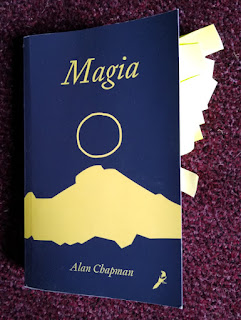The Rune Poems: A Reawakened Tradition
This is not a review but a plug, because I have two poems in this volume. The book is in two sections - ‘The Older Rune Poems’ and ‘The Reawakened Tradition’. Most of our knowledge of the meanings of the runes comes from the mediaeval rune-poems, Anglo-Saxon, Icelandic and Norwegian. The first section has original language versions and new translations of all of those, of the very brief Abecedarium Nordmannicum and of a previously little-known Early Modern Swedish rune poem.
This section starts with an essay by P. D. Brown, in which he presents the rune-poem tradition from the viewpoint of a poet. He tells us that the poems were tools “to make the mind more generally agile, more adept at making connections, thinking ‘laterally’ and more imaginatively” about what the runes in are. The old rune-poems themselves are given with learned notes about the language and meanings.
The second part contains an introduction by P. D. Brown. He writes: ‘A rune poem mingles and blends the fruits of two of Odhinn’s greatest mythical adventures: the winning of the Mead of Inspiration and the revelation of the runes. One cannot write a rune poem without absorption in the practice of writing poetry and the study of runes. It is the editors’ hope that readers will be moved … to compose their own rune poems.’
Twenty rune poems by contemporary runic magicians follow. One of the fascinating features of this collection is the sheer range of meanings that are revealed for each rune, expanding our understanding as we read the poems. Some of the poems explore traditional Germanic poetic forms and some introduce a lot of formal variety. In David Jones’s rune poem each verse has nine lines with nine syllables per line. P.D. Brown presents us with an elaborate and sophisticated ‘Crown of 28 Runes’, the only poem using the Anglo-Saxon row (for more details on this poem see my review of PD Brown’s book Crown of Runes at https://chaotopia-dave.blogspot.com/2020/03/a-crown-of-runes-and-other-books-by-p-d.html ), and a twelve-verses short poem of the Elder Futhark for voice recitation. Dawid Rudzinski’s poem is in Polish (with English translation), and includes a visual poem, a series of 24 etchings. Nathalie Forner’s poem is in French, with her translation. Another poem, by Ian Read, formed the lyrics for part of his 1996 album Rûna. Both my Elder and Younger Futhark poems are in here. Ristandi and I are the only modern authors of Younger Futhark poems represented.
The book also includes an exhaustive multilingual bibliography, which should satisfy the most information-hungry student. This is the kind of thing the RG does so well - employing the academic side of Germanic esotericism to nurture the poetry and the magick. Most of the authors are members of the Rune-Gild, and the diversity of this collection showcases how that organization has grown into a vibrant creative community.
Buy this book if you are curious about the rune poems and want something readable but carefully-referenced, buy it if you’re curious about the modern world of rune-magick, buy it for the poems themselves and the pleasure of reading them.
Here’s a verse from my Younger Futhark Rune-Poem:
HAGAL ᚼ hagall ("hail")
Hail breaks stems and frightens kine
Hail lays waste to detailed care
Hurts expectations, blasts what’s mine
Hands us a world that seems so bare. Yet
Harms us with a jewelled shine,
Holds us to what’s truly there:
Hagal’s Goddess in disguise -
Hail the twinkle in Her eyes!




Comments
Post a Comment